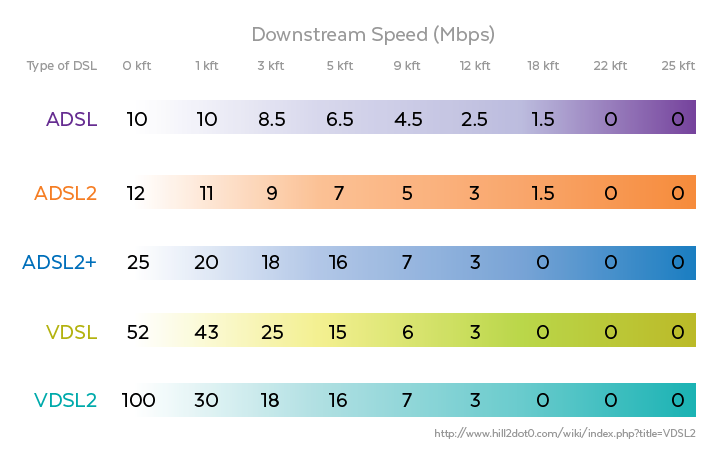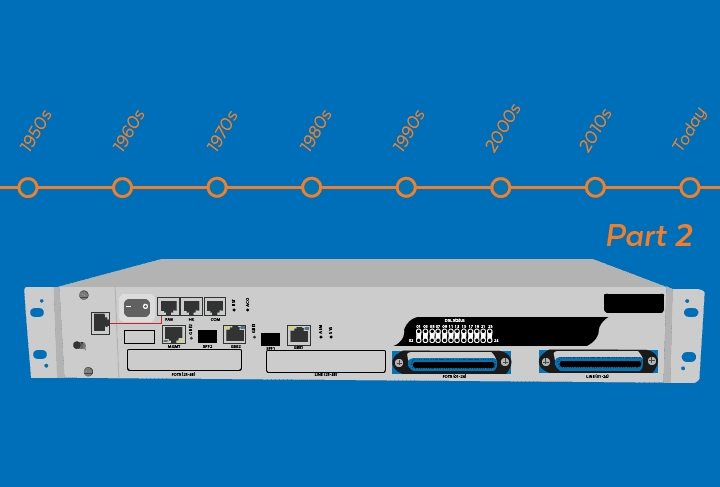After examining the brief history of DSL, you might be wondering about new multiplexing methods that ISPs have developed to improve transmission speeds via copper lines. The following provides an overview of the most popular types of DSL services in use today.
SHDSL– Symmetric Digital Subscriber Line
SHDSL transmits symmetrical download and upload speeds and is oftentimes compared to ADSL in terms of speed and efficiency. Described as a “business-grade service” SHDSL “comes with guaranteed reserved bandwidth and sync…and has a contention ratio of 1:1”. This guarantees a consistent throughput. SHDSL is not susceptible to congestion. According to Lantiq, “SHDSL-based transceivers can achieve data rates of up to 15 Mbps per copper pair or reach far beyond 15 kilometers (9.3 miles)”.
 ADSL-Asymmetrical Digital Subscriber Line
ADSL-Asymmetrical Digital Subscriber Line
Unlike SHDSL, ADSL offers faster download than upload speeds, thus asymmetrical speeds. ADSL reserves more bandwidth for download usage since the typical internet browser consumes more media than he uploads. Having access to faster download speeds more than sufficiently covers the broadband needs of the average user. At its source, ADSL offers downlink speeds of 8 Mbps and can reach as far as 5.5 Km with speed attenuation.
ADSL2– Asymmetrical Digital Subscriber Line
ADSL2 is the second generation of ADSL and offers nearly twice the speed of ADSL. ADSL2 offers a number of improvements including modulation efficiency, coding gain, and dynamic rate adaptation. To view an interactive video about dynamic rate adaptation, click here. ADSL2 requires subscribers to upgrade from an ADSL modem to an ADSL2 modem to adopt the newer standard. Asymmetrical DSL technology can reach download rates of up to 12Mb at its source and can reach as far as 5.5 Km with speed attenuation. Click here for more in-depth information about ADSL2.
ADSL2+
ADSL2+ offers a near two-fold speed improvement over ADSL2. ADSL2+ boasts a wider bandwidth channel with double the frequency range of ADSL2. ADSL operates in the .14 MHz to 1.1 Mhz frequency range while ADSL2+ operates in the .14 to 2.2 Mhz range. The wider channel bandwidth of ADSL2+ allows it to achieve downstream data rates of 24 Mbps at its source. ADSL2+ can retain downlink rates of 20 Mbps up to distances of 1 km. For a more in-depth comparison between ADSL2 and ADSL2+, click here!
VDSL–Very High Bit Rate Digital Subscriber Line
VDSL provides considerably faster speeds than ADSL but supports shorter link lengths. VDSL utilizes 25Khz to 12 MHz frequency band and can easily support bandwidth-intensive triple play services such as voice, video, data and high-definition. VDSL2 can achieve up to 52 Mbps at its source and can reliably retain similar data rates up until 300 meters. VDSL however, can reach up to 1,000 meters with attenuated rates.
VDSL2
VDSL2 offers improved vectoring and higher bit rates, as well as faster upload speeds when compared to ordinary VDSL. VDSL2 vectoring can measure the crosstalk in each binder and generate an anti-phase signal to cancel noise. VDSL2 can provide symmetrical and asymmetrical aggregate data rates of up to 200Mbps downstream and upstream. VDSL2 occupies frequencies between 2.2 MHz and 12 Mhz. VDSL2 can efficiently reach up to 1.6 km after which performance starts resembling ADSL2+.
XDSL technology has come a long way since its original iteration. To learn more about the history of ADSL, click here


